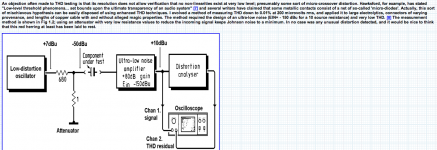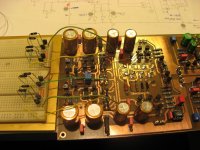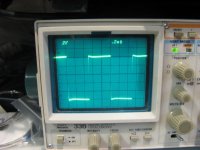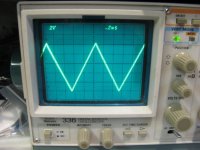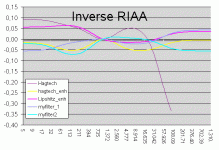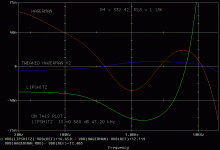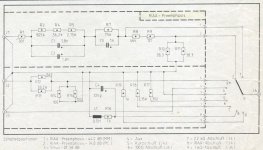I'm not too worried about the measurements. I always had this line (60hz and harmonics) related noise with my test setup when measuring phono section. It is caused mainly because the test equipment is not floating. When I measured my LC Audio light supplied head amp section, the measured noise was much lower, mainly because the head amp was not connected to any supply.
I expected better result with an actual cartridge (and much lower resistance than 50ohms, thanks MiiB) and with the actual separate enclosures and shielding. I'll use cases made of steel. My test setup had flying alligator clip jumpers, and the actual pre-reg pcb was close to the preamp.
My measurements indicates I think that the preamp is working nicely. Yes both channels imbalance for the RIAA can be tuned by fine tuning the RIAA capacitors. I'll do it in the assembled cases.
I was pleased to see that both channels have the same gain, at 61.4dB and that the small dc offset at the input was easy to null out. All the Gain Cell matched resistors are within 113 and 115mv, both channels, indicating a very good match. To make sure the matched quads were correct, I installed them on a breadboard outside of the PCB. Once I was sure they were well matched, I soldered them in place.
Here is what I got driving at -60dB the input using a reverse RIAA network (From Hagerman Audio). You can see that the square and triangle are almost perfect, indicating that all their harmonics were correctly amplified by the RIAA curve. For me the reverse RIAA is always the fastest way of testing rapidly for good RIAA correction.
I expected better result with an actual cartridge (and much lower resistance than 50ohms, thanks MiiB) and with the actual separate enclosures and shielding. I'll use cases made of steel. My test setup had flying alligator clip jumpers, and the actual pre-reg pcb was close to the preamp.
My measurements indicates I think that the preamp is working nicely. Yes both channels imbalance for the RIAA can be tuned by fine tuning the RIAA capacitors. I'll do it in the assembled cases.
I was pleased to see that both channels have the same gain, at 61.4dB and that the small dc offset at the input was easy to null out. All the Gain Cell matched resistors are within 113 and 115mv, both channels, indicating a very good match. To make sure the matched quads were correct, I installed them on a breadboard outside of the PCB. Once I was sure they were well matched, I soldered them in place.
Here is what I got driving at -60dB the input using a reverse RIAA network (From Hagerman Audio). You can see that the square and triangle are almost perfect, indicating that all their harmonics were correctly amplified by the RIAA curve. For me the reverse RIAA is always the fastest way of testing rapidly for good RIAA correction.
Attachments
Yes especially phase shift between input and output
I use Hagerman as well as anti RIAA and I am aware of that.
Eventually to go around that I will try to measure up single frequency at correct level direct from Sig Gen but my test rig is quite inadequate and I rely mostly on listening
Which compared to your results sems pretty reliable.
I asked a while ago how to make small changes in gain quite a while ago maybe this make more sense now after your post...
PS do you use same IRC or Welwyn there? and watch out for those gold electrolitics (from Rapid?) leackagge currentis prety baad if same as same I have had in the past
I use Hagerman as well as anti RIAA and I am aware of that.
Eventually to go around that I will try to measure up single frequency at correct level direct from Sig Gen but my test rig is quite inadequate and I rely mostly on listening
Which compared to your results sems pretty reliable.
I asked a while ago how to make small changes in gain quite a while ago maybe this make more sense now after your post...
PS do you use same IRC or Welwyn there? and watch out for those gold electrolitics (from Rapid?) leackagge currentis prety baad if same as same I have had in the past
Last edited:
So to resume, you want phase shift measurement between input and output, but with the inverse RIAA inline with the input?
And Joachim Gerhard what is even more fun with my Paradise it that the pcb I made were almost perfect. Less than 3 small corrections to make to my first prototype, mostly forgotten ground connections. I'm very happy with the result
And Joachim Gerhard what is even more fun with my Paradise it that the pcb I made were almost perfect. Less than 3 small corrections to make to my first prototype, mostly forgotten ground connections. I'm very happy with the result
Last edited:
The Hagtech reverse RIAA looks pretty dodgey to me.
Also check the capacitor values.
The Audio Express article states 6.2n...
...The kit states 6.6n ( 2x 33n )
I thought this was a misprint in the Audio Express article when I first spotted it...
...but it appears not to be...
...the value changed, for the kit.
They could have used 4.7nF + 1.5nF...
...but didn't.
Also worth noteing are the lack of plots in the Audio Express article...
...& in the kit PDF, where there are none at all.
The kit PDF also states :- the unit is for testing 'modern' phono-stages, ie. Neumann pole types.
Then goes on about phase problems you might have with other phono-stages ( ie. non Neumann pole stages ).
Perhaps good for playing white-noise to your phono-stage from a CD or electronic device...
...but for testing............................................................?
Cheers
Si.
Also check the capacitor values.
The Audio Express article states 6.2n...
...The kit states 6.6n ( 2x 33n )
I thought this was a misprint in the Audio Express article when I first spotted it...
...but it appears not to be...
...the value changed, for the kit.
They could have used 4.7nF + 1.5nF...
...but didn't.
Also worth noteing are the lack of plots in the Audio Express article...
...& in the kit PDF, where there are none at all.
The kit PDF also states :- the unit is for testing 'modern' phono-stages, ie. Neumann pole types.
Then goes on about phase problems you might have with other phono-stages ( ie. non Neumann pole stages ).
Perhaps good for playing white-noise to your phono-stage from a CD or electronic device...
...but for testing............................................................?
Cheers
Si.
Attachments
Reverse RIAA is always going to be a compromise as long as we pick one to give consistent results across the pond I see no problem.
I am not going to fuss about 0.1 dB difference considering that before the sound get in to the groves it goes trough quite a lot of gadgets with loads of knobs (instrument tone controls mixing desk controls, pre-mastering "producer” tone controls master before cutting tone controls and here possibly a Newman pole that changes between each machine) then consider that each record came out at different times and was then tuned to the mass media typical sound system in use then ad this includes "gettoblasters"
So give me one that is easy to cook and stick to that. Algar did a lot of work so Hagerman is fine by me.
About Neumann pole Mr Neumann builds the lathes that cut your record to improve the reliability (arm breaking off and flying away) he added a resistor to make a further pole not all lathes have one and not all lathe have the same.
He himself was surprised by the use of his name for it.
Use it or not is a mater of taste but not a standard.
I am not going to fuss about 0.1 dB difference considering that before the sound get in to the groves it goes trough quite a lot of gadgets with loads of knobs (instrument tone controls mixing desk controls, pre-mastering "producer” tone controls master before cutting tone controls and here possibly a Newman pole that changes between each machine) then consider that each record came out at different times and was then tuned to the mass media typical sound system in use then ad this includes "gettoblasters"
So give me one that is easy to cook and stick to that. Algar did a lot of work so Hagerman is fine by me.
About Neumann pole Mr Neumann builds the lathes that cut your record to improve the reliability (arm breaking off and flying away) he added a resistor to make a further pole not all lathes have one and not all lathe have the same.
He himself was surprised by the use of his name for it.
Use it or not is a mater of taste but not a standard.
Mr. Neumann was long dead when Stereo records where introduced. Anyway, i think basically the same. Channel balance is more important then plus-minus 0.1dB RIAA precision, although that comes automatically with good channel balance. We have discussed this here anyway. Ricardo and Sampler came up with fine tunings of the Paradise with mathematical means that have shown that it can be set up with extremely good precision.
Here is some information about the Neumann pole :Cut and Thrust: RIAA LP Equalization | Stereophile.com
Paradise PSU
Following my initial quest about powering the Paradise with only one TX, I was lucky to get FdW full attention on the subect.
We have been working on this project in the backstage and finally agreed with a layout. I successfully built it and it works wonderfully. (One TX feeding double preregs to power both riaa boards independently and so got lower crosstalk from the raw psu).
During this work we also came up with a new grounding schematic for the riaa preamp and the TT that I believe can easily be implemented in any system.
I want to openly thank Frans for all the night work and inconditional support
Hi
Can I use only one TX to feed two prereg psu´s to power the Paradise ?
I have one suitable TX that has double output windings and would like to minimize crosstalk using double bridges and caps, forming two psu´s.
I am afraid this might cause hum due to using the same TX secondaries to feed both bridges in parallel.
Following my initial quest about powering the Paradise with only one TX, I was lucky to get FdW full attention on the subect.
We have been working on this project in the backstage and finally agreed with a layout. I successfully built it and it works wonderfully. (One TX feeding double preregs to power both riaa boards independently and so got lower crosstalk from the raw psu).
During this work we also came up with a new grounding schematic for the riaa preamp and the TT that I believe can easily be implemented in any system.
I want to openly thank Frans for all the night work and inconditional support
A RIAA preemphasis test box using E48 resistor values:
Where does this scheme come from?
Thanks.
Are you posting the final result, in one of the paradise threads?
As soon as I have some time (to give it the proper attention) I will publish it in the Mpp thread (about halve way next week I think).
